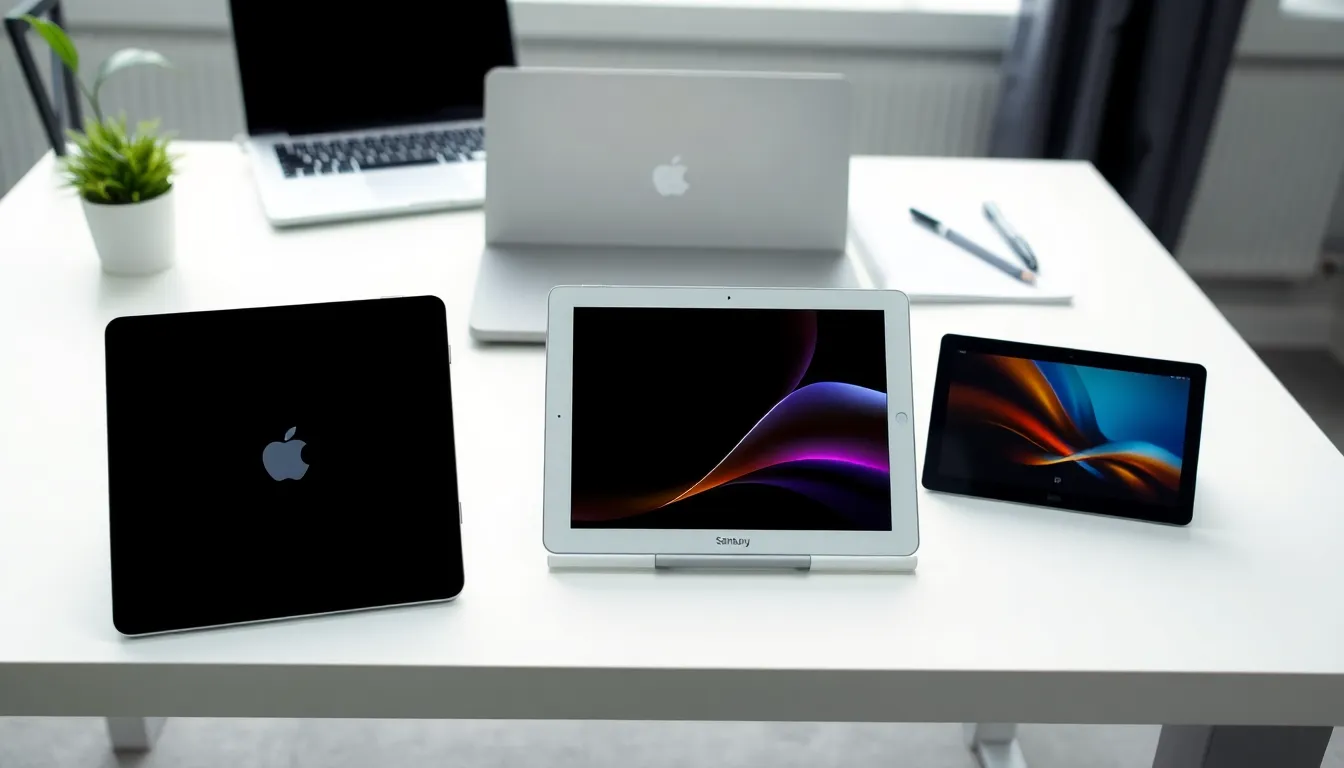In a world where smartphones keep getting bigger and laptops keep getting lighter, the tablet market has carved out its own cozy niche. It’s the Goldilocks of tech—just right for those who want a screen bigger than their phone but smaller than their laptop. With the rise of remote work and binge-watching marathons, tablets have become the unsung heroes of productivity and entertainment.
Table of Contents
ToggleOverview of Tablet Market Share
Tablet market share reflects the competitive landscape among leading manufacturers. In 2022, Apple dominated this segment with a remarkable 30% share, primarily driven by the popularity of the iPad. Samsung followed, securing approximately 20% of the market, thanks to its Galaxy Tab series.
Various brands contribute to the growth of this market. Amazon, for instance, captured about 10% of the share with its budget-friendly Fire tablets. Lenovo and Microsoft also hold significant portions, focusing on business-oriented devices. Their tablets cater to specific needs, further diversifying consumer options.
Growth trends indicate a shift towards higher-end models. Premium tablets entice consumers with advanced features and better performance, reflecting a willingness to invest in technology. The digitalization of workplaces has solidified tablets’ role as productivity tools. Users engage in video conferencing, document editing, and virtual collaboration seamlessly across devices.
Emerging technologies influence these trends. Increased connectivity and enhanced display technologies drive consumer interest. Additionally, the surge in gaming and entertainment applications leads to higher tablet adoption rates. Many users prefer tablets for multimedia consumption over laptops and desktops.
In terms of regional performance, North America and Asia-Pacific lead in sales volume. Europe shows a steady growth trajectory, as consumer preferences evolve. The pandemic accelerated demand, indicating a shift in how people utilize devices for both work and leisure.
Tablet market share remains dynamic, with brands continually innovating. Manufacturers focus on improving battery life, performance, and user experience. These adjustments ensure tablets stay relevant amid changing consumer demands. Overall, the tablet market thrives as it adapts to ongoing technological advancements and shifts in user behavior.
Key Players in the Tablet Market

The tablet market features several significant competitors, each contributing to its dynamic landscape. Apple, Samsung, and Microsoft stand out as the leading brands, capturing substantial market shares.
Apple
Apple dominates the tablet sector with a commanding 30% market share, largely attributed to the iPad’s strong popularity. This brand excels due to its seamless ecosystem, integrating hardware, software, and services. Consumers often favor the iPad for its ease of use and high-quality build. The introduction of various models, catering to different budgets, further broadens its appeal. Advanced features, such as the M1 chip, also enhance performance, attracting tech-savvy users.
Samsung
Samsung holds the second position in the tablet market with a 20% share, driven by its Galaxy Tab series. This brand emphasizes versatility, providing models that range from budget-friendly options to premium devices with high-end specifications. The emphasis on display quality and multitasking capabilities makes Samsung tablets appealing for both productivity and entertainment. Regular software updates ensure the user experience remains fresh, allowing Samsung to maintain a loyal customer base.
Microsoft
Microsoft positions itself as a key player with its Surface line of tablets. These devices cater primarily to professionals seeking a balance between tablet functionality and laptop performance. A strong emphasis on productivity features, such as an integrated keyboard and compatibility with Microsoft Office, enhances their appeal. The Surface Pro series offers a premium experience, allowing users to leverage the Windows operating system effectively. This brand continues to innovate, focusing on meeting the needs of remote workers and business professionals alike.
Tablet Market Trends
Tablet market trends reflect evolving consumer needs and preferences. Growth rates indicate a robust market, driven by remote work and digital consumption.
Growth Rates
Tablet sales saw an increase of 18% in the last year, showcasing strong momentum. The demand surged during the pandemic and recorded significant sales, particularly in North America and Asia-Pacific. As companies adapt to hybrid work models, tablets become essential for both professionals and casual users. Forecasts suggest continued growth, with an annual increase expected to reach 12% over the next five years. Manufacturers respond to the rising trend by improving device capabilities and expanding product lines. High-end tablets particularly attract attention, as consumers invest more in technology and features.
Consumer Preferences
Consumer preferences shift towards versatile tablets, emphasizing performance and usability. Users increasingly favor models equipped with advanced displays, connectivity options, and longer battery life. The rise in gaming and multimedia consumption drives interest in high-performance devices. Many prioritize brands like Apple and Samsung due to their reputation for quality and innovation. Additionally, affordability and value play significant roles in purchase decisions. Tablets that cater to gaming and productivity simultaneously capture significant market interest. Flexible pricing strategies and diverse model offerings enhance brand appeal across various consumer demographics.
Regional Analysis of Tablet Market Share
Tablet market share varies significantly across regions, driven by factors such as consumer preferences and technological adoption.
North America
North America leads the tablet market, boasting a significant portion of sales. Apple dominates this landscape with over 30% market share, primarily from iPad sales. Samsung follows closely with about 20%, catering to diverse consumer needs. The rise of remote work further fuels demand, with users seeking flexibility for both productivity and leisure. Increased connectivity and advanced app ecosystems enhance the overall user experience, encouraging more consumers to invest in tablets. Sales in this region reflect an appetite for innovative features, highlighting a trend towards higher-end devices.
Asia-Pacific
Asia-Pacific showcases robust growth in tablet adoption, contributing significantly to global market share. This region benefits from a large population and increasing disposable incomes, making tablets more accessible. Notably, manufacturers like Xiaomi and Huawei are gaining traction alongside Apple and Samsung, diversifying consumer choices. Emphasis on digital learning and remote work drives demand, especially among younger demographics. Enhanced specifications in gaming and multimedia functions attract users focused on entertainment. The rapid expansion of e-commerce also contributes to the surge in tablet sales across various countries in Asia-Pacific.
Europe
Europe experiences steady growth, with tablet sales rising as consumers embrace diverse functionalities. Apple maintains a strong presence, followed by Samsung, while local brands also carve out market niches. An increasing number of professionals leverage tablets for work, utilizing features that support multitasking and productivity. Additionally, consumers show interest in affordable options, enhancing the competitiveness of various manufacturers. Technological advancements in display and battery life contribute to sustained demand. Europe’s unique blend of work and leisure usage shapes its tablet market, fostering continuous evolution in product offerings.
Future Outlook of Tablet Market Share
Tablet market share is set for continued growth, driven by evolving consumer preferences and technological advancements. Forecasts indicate an annual growth rate of 12% over the next five years, highlighting increasing demand for versatile tablets. Demand stems from remote work and digital content consumption, especially among professionals and students.
Apple’s iPad remains a frontrunner with a 30% market share, leveraging its robust ecosystem and cutting-edge features. Samsung holds 20% of the market, with its Galaxy Tab series appealing due to innovative design and display quality. Emerging competitors like Xiaomi and Huawei are gaining traction in the Asia-Pacific region, fueled by lower prices and enhanced functionalities.
Consumer interest shifts toward high-end models, reflecting a willingness to invest in advanced features for gaming and multimedia. The integration of improved connectivity options also shapes purchasing decisions, appealing to users requiring seamless online experiences. Regional growth remains notable, particularly in North America and Asia-Pacific, where robust demand drives innovation.
North America leads in sales and is characterized by substantial purchases from brands like Apple and Samsung. In Asia-Pacific, increasing disposable incomes and growing digital learning initiatives contribute to expanding market share. Europe exhibits steady growth, with a diverse mix of local and international brands catering to both professionals and budget-conscious consumers.
The future landscape of the tablet market promises ongoing innovation as manufacturers adapt to emerging trends and consumer behavior shifts. Enhanced battery life, performance improvements, and user-friendly interfaces are priorities for brands aiming to maintain competitiveness in this dynamic industry.
The tablet market is poised for significant growth as it adapts to the evolving needs of consumers. With strong players like Apple and Samsung leading the charge the demand for high-performance devices continues to rise. Emerging technologies and enhanced features are driving interest particularly among professionals and students who seek versatility in their devices.
As remote work and digital learning become more prevalent tablets are solidifying their place as essential tools for productivity and entertainment. The ongoing innovation in battery life performance and user experience will ensure that tablets remain relevant in an increasingly competitive landscape. The future looks bright for the tablet market as it embraces change and meets the demands of modern users.




